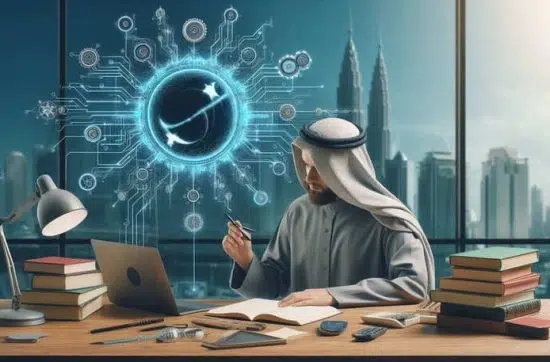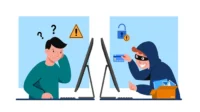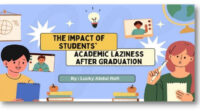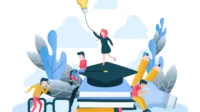Arabic Language Learning’s Evolution in the Digital Age
Human life has changed significantly as a result of the advancement of digital technology.
Nearly all human actions are now conducted through digital technology due to technical breakthroughs, particularly in the digital era.
Nowadays, digital technology affects every aspect of life, including purchasing and selling, payment transactions, and educational procedures.
also holds true for Arabic language instruction, which has been impacted by recent events.
Learning activities today provide a multitude of opportunities, facilitate access to education, and enable the learning process to be carried out in a flexible manner by leveraging current technological breakthroughs.
Learning Arabic is now possible anywhere and at any time.
Since not everyone has access to appropriate technology, the digital age also brings new difficulties for some tech users, such as restricted internet connection and a shortage of suitable gadgets.
The possibility of interruptions throughout the learning process and the requirement that both teachers and pupils adjust are additional difficulties.
This article attempts to shed light on these processes in order to offer suggestions for methods of raising learning standards, especially in the area of Arabic language instruction.
Baca juga: The Impact of the Audiolingual Approach on Young Learner’s Capabilities in Arabic
Arabic Language Learning Methods’ Revolution in the Age of Modern Technology
The use of technology media alone is not the only way that Arabic language instruction is changing in the digital age; other approaches, techniques, and learning strategies are also being used.
Arabic language instruction used to be mostly lecture-based, with teachers delivering the content and students primarily listening and memorizing it.
Today’s learning approaches are more varied and engaging due to technological improvements.
Numerous digital resources are now available to aid in learning Arabic, including the Nahwu Sharaf Digital app, Duolingo, and a number of content producers that have begun creating Arabic-language instructional films.
In order to manage assignments and learning resources, students have also started using Learning Management Systems (LMS) like Google Classroom and Moodle.
Additionally, with the help of numerous auxiliary programs like Canva and others, Arabic language learning resources can now be imaginatively created.
These tools allow teachers to produce animated movies for muhadatsah (Arabic discussions).
Learning Arabic can be done more efficiently and even reach students in different places by making the most of digital media.
I definitely find the digital-based learning method to be very beneficial in my role as an Arabic language instructor at an institution.
In order for me to concentrate on delivering the topic and kicking off a discussion, I typically send the learning materials to the students via group chat before the lesson begins.
Additionally, teachers may generate instructional media much more easily with apps like Canva and others.
Numerous more tools, including Quizizz and comparable platforms, are also accessible for making online games in the classroom.
Baca juga: Arabic Language Learning System at al-ismiah Islamic Boarding School
Improving the Quality of Arabic Language Learning through the Optimization of Digital Technology
There are now a lot of chances to study Arabic thanks to the digital age.
One of these is increased accessibility to educational resources, which enables students to learn using a variety of digital resources, such as e-books and learning programs.
Videos and instructional games that enhance the learning experience are among the more varied and captivating learning materials available today.
Students are therefore less prone to experience boredom during class.
Applications or links to websites that offer games might be a useful remedy and encourage a passion for studying Arabic.
Personalized learning is now more possible because of the availability of digital resources and tools for learning Arabic.
Pupils can choose readings that correspond to their comprehension level and even go over difficult passages on their own.
Additionally, there are a lot of channels on websites like YouTube that offer easily available Arabic study materials and courses, including Maha Arabic Center, Arab Podcast, and others.
These channels are extremely helpful for self-directed learning.
Online discussion platforms, such WhatsApp study groups or cooperative learning projects with students from distant areas or even different nations, have also made collaborative learning more simple.
With the help of modern technology, students can even practice pronouncing words correctly by practicing with masyaikh and interacting directly with native Arabic speakers.
With the ability to learn directly from native speakers even over thousands of kilometers, in-person encounters are no longer required.
Challenges of Arabic Language Learning Amid the Digital Divide
Although it offers many opportunities, digital transformation also presents its own challenges, such as the digital divide.
Not all students have adequate devices or reliable internet access.
Many of them must climb mountains or travel from remote villages to urban areas just to access online learning.
As a result, online education becomes uneven and poses a significant barrier for some students.
Bi’ah, or a supportive atmosphere, is essential when studying Arabic because language acquisition entails more than just memorization of theoretical information it also entails learning to communicate.
One of the biggest barriers to effective learning is the lack of practice and usage of the language.
Therefore, if an encouraging Arabic language environment is not created together with online study, it can be seen as less effective.
Students must actively create such an environment themselves, whether by practicing with classmates or family members like parents or siblings.
This is where their initiative is put to the test.
Baca juga: Bahasa Arab Mudah: Solusi Jitu dalam Menghadapi Kesulitan Belajar Bahasa Arab
Creating the Future of Arabic Language Instruction in the Age of Digitalization
It is inevitable that Arabic language instruction will change in the digital age, and this change has had a big impact on the educational landscape.
On the one hand, there are several ways that technology can facilitate, adapt, and enhance the learning process.
However, issues including unequal access, inadequate teacher training, and a lack of digital tools continue to be common worries.
As a result, it is crucial that educational institutions and teachers keep coming up with new ideas, introducing interesting teaching strategies and media, and making sure that technology is used as a tool to help students learn rather than just as a formality.
With the correct strategy, the internet age might be a fantastic chance to encourage students in Indonesia and perhaps globally to become enthusiastic about learning Arabic.
Penulis: Wirdatul Qudsiah
Mahasiswa Jurusan Arabic Education Department, Universitas Muhammadiyah Prof Dr HAMKA
Supervisor: Dr. Muhammad Iman Sastra Mihajat, Ph.D
Editor: Anita Said
Bahasa: Rahmat Al Kafi
Ikuti berita terbaru Media Mahasiswa Indonesia di Google News















